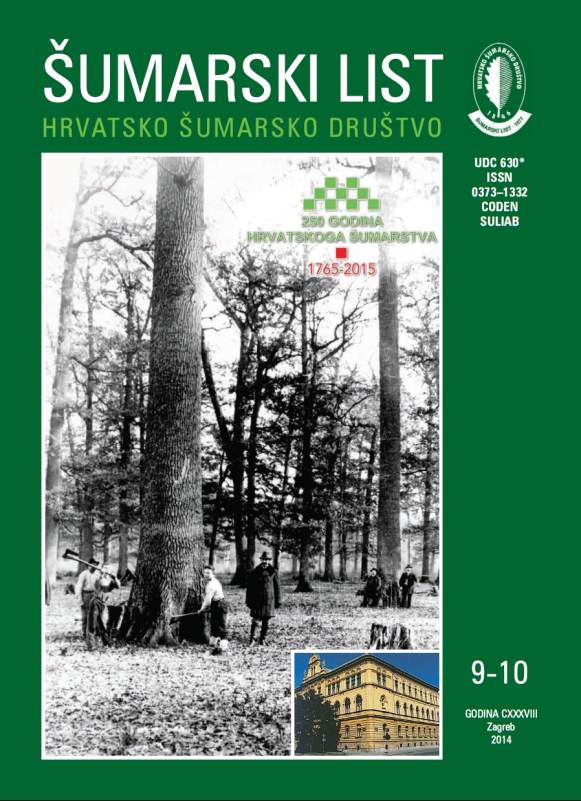
broj: 9-10/2014
pdf (10,9 MB) |
|
||||||||||||||
| RIJEČ UREDNIŠTVA | ||
| Uredništvo | ||
| AWAITING THE 250TH ANNIVERSARY OF ORGANIZED FORESTRY IN CROATIA pdf HR EN | 437 | |
| IZVORNI ZNANSTVENI ČLANCI | ||
| Igor STANKIĆ, Jurij MARENČE, Dinko VUSIĆ, Željko ZEČIĆ, Zlatko BENKOVIĆ | UDK 630*537 (Fagus sylvatica L.) (001) | |
| STRUCTURE OF THE COMMON BEECH ABOVEGROUND TREE BIOMASS IN DIFFERENT STAND CONDITIONS pdf HR EN | 439 | |
| Dražen DEGMEČIĆ, Tihomir FLORIJANČIĆ | UDK 630*156 (Cervus elaphus, L.) (001) | |
| THE IMPACT OF CLIMATE AND HYDROLOGICAL FACTORS ON DEVELOPEMENT OF RED DEER (Cervus elaphus, L.) ANTLERS IN THE CROATIAN PART OF BARANJA DANUBE REGION pdf HR EN | 451 | |
| Summary Habitat is defined as a set of natural resources and conditions present in a given area that ensures the stability of the population that it inhabits. Antlers of Cervidae family are an example of fast growing tissues and the only organs of the mammals capable of complete regeneration. Each year the antlers are discarded and each year the new set of antlers are grown. This is called a cycle of antler growth and it is closely associated with the reproductive cycle, hormonal processes, climate and hydrological factors. Climatic and hydrological factors can influence directly through air temperature, precipitation (rain, snow), ground cover (rain, snow), sunlight hours (photoperiod) and hydro levels. Climatic and hydrological factors can influence indirectly through vegetation as a source of food. The aim of this paper is to link climate and hydological factors with the developement level of red deer antlers. The research area is periodically flooded parts near the rivers of Danube and Drava and it lies in the northeastern part of Republic of Croatia, on the border with Hungary and Serbia. At this unique natural areas one can find habitats for many species of plants and animals and it also represents an preserved habitat of red deer (Cervus elaphus). The study lasted for six hunting years – from 2004/2005. to 2009/2010. For this current study the data were taken from middle aged and mature stags (five and more years old). Total of 382 stags were measured. The value of antlers were observed through the following traits of red deer antlers: antler weight, total lenght of branches, lenght of tird tine and the number of tines. Hunting year 2007/2008. showed values of observed characteristics significantly higher than hunting years of 2004/2005., 2005/2006. and 2006/2007, as compared to hunting year of 2008/2009. and 2009/2010. observed values were not significantly higher but they were higer and that is in a biological sense equally important. The management measures were the same throught the years of research. Hydrological report showed that regular spring flooding of the Danube river failed in year 2007. and that was not the case during the other years of research. It would be normal that the average monthly temperature during the coldest months for this habitat was below zero but during the end of 2006. (November and December) and in the beginning of 2007. (Januar and Februar) the average temperature was from 2,9 to 8,4 °C above zero. That was the maximum temperature during the winter in 10 year period and that was winter with the least number of cold days (<0,0 °C) (35 days during these four months). Rainfall in the first three monts of 2007. were slightly above average (142 l) but during April and May the level of rain was up to three time lower in the relation to the other years of research. Number of days with snow was only two days during the coldest months of 2006. and 2007. and the height of snow cover for this two days was 1 cm. In the first five months during 2007. there were more sunshine hours than in other years of research, especially during the month of April when the growth and developement of antlers is most intense. Based on the results presented in the text above the values of measured antler traits were highest in huntig year 2007/2008. and that was because of extremely favorable climatic and hydrological conditions in a significant time for antler growth and developement. The results from this research can be a guidance for future prediction of red deer antler developement in a sence of creating management measures. Key words: Cervus elaphus; antlers; climate; hydrology; Baranja | ||
| Goran JELIĆ, Vlado TOPIĆ, Lukrecija BUTORAC, Zoran ĐURĐEVIĆ, Anamarija JAZBEC, Milan ORŠANIĆ | UDK 630*232 (001) | |
| CONTAINER SIZE AND SOIL PREPARATION EFFECTS ON AFFORESTATION SUCCESS OF ONE YEAR OLD STONE PINE (Pinus pinea L.) SEEDLINGS IN CROATIAN MEDITERRANENAN AREA pdf HR EN | 463 | |
| PRETHODNO PRIOPĆENJE | ||
| Andrej VERLIČ, Nataša ĐURIĆ, Žiga KOKALJ, Aleš MARSETIČ, Primož SIMONČIČ, Krištof OŠTIR | UDK 228+614 | |
| TREE SPECIES CLASSIFICATION USING WORLDVIEW-2 SATELLITE IMAGES AND LASER SCANNING DATA IN A NATURAL URBAN FOREST pdf HR EN | 477 | |
| STRUČNI ČLANCI | ||
| Alojzije FRKOVIĆ | UDK 630*156 (Axis axis Erxleben 1977) | |
| INTRODUCTION OF THE AXIS DEER (Axis axis Erxleben 1977) TO THE CROATIAN LITTORAL IN 1953 pdf HR EN | 489 | |


